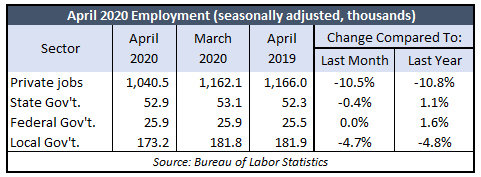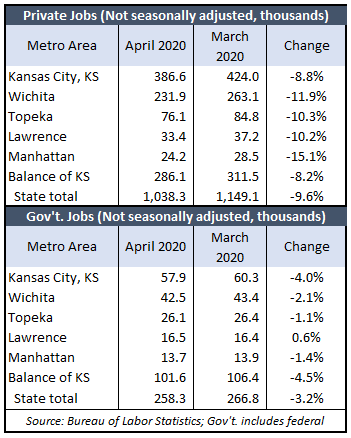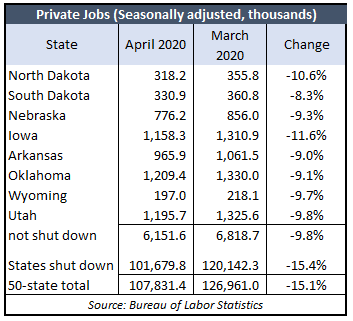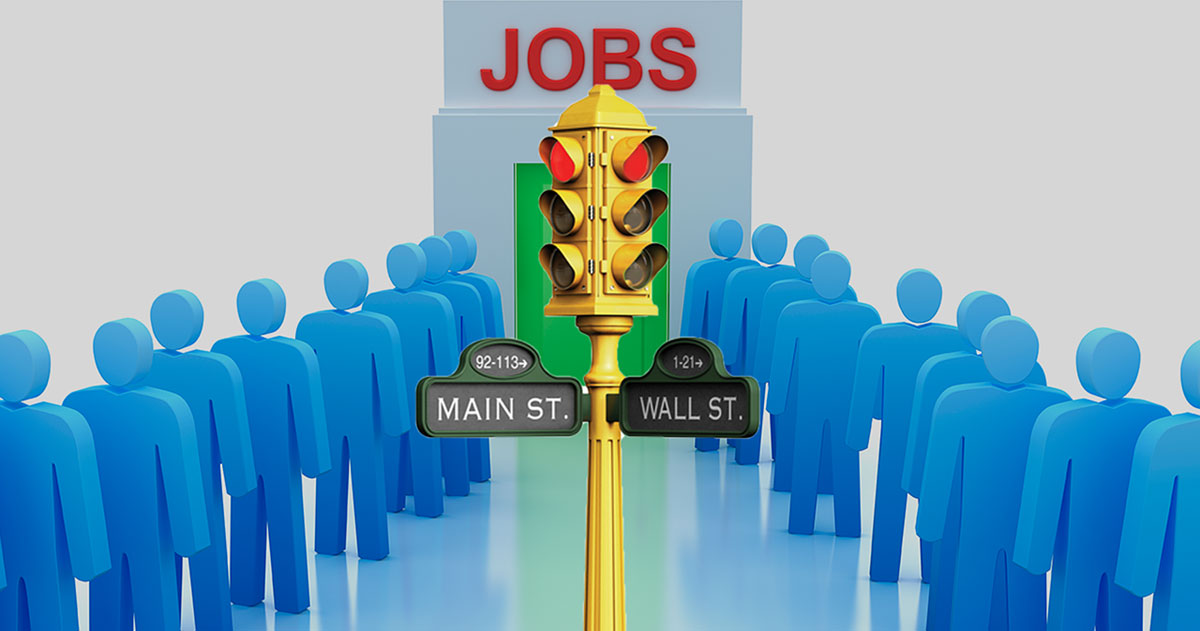Kansas Governor Laura Kelly’s mandatory shutdown order caused the loss of almost 122,000 private-sector jobs in April, but state government jobs held steady according to the Bureau of Labor Statistics.
 Private-sector employment plummeted 10.5% compared to March 2020. The largest one-month decline in the Great Recession was 0.7% in February 2009. State government workers declined by 0.4% but there were 600 more state workers in April 2020 than in April 2019; there were 125,000 fewer private workers than a year ago.
Private-sector employment plummeted 10.5% compared to March 2020. The largest one-month decline in the Great Recession was 0.7% in February 2009. State government workers declined by 0.4% but there were 600 more state workers in April 2020 than in April 2019; there were 125,000 fewer private workers than a year ago.
Federal government employment didn’t change over March but there 400 more workers than a year ago. Local government employment dropped by 4.7% over March, and there were 8,700 fewer local government workers than a year ago.
April’s private job total of 1.04 million was the lowest since July of 1997. The unemployment rate of 11.2% is far greater than the worst of the Great Recession of 7.2%, and Kansas is one of the states that set a new unemployment record since 1976 according to BLS.
Job change by region
Seasonally-adjusted results, as above, are not available for all areas of Kansas yet, but data that’s not seasonally-adjusted shows the Manhattan metro area had the largest decline compared to March, at 15.1% representing a decline of 4,300 jobs.
 The Wichita metro area suffered the second-largest loss, at 11.9%, with about 31,000 fewer private jobs. The Topeka and Lawrence metro areas each lost a little over 10% of their private-sector jobs, and the Kansas side of the Kansas City metro lost 8.8% of its private workforce, dropping 37,400 workers. The rest of the state lost 25,400 jobs or 8.2% of the March private jobs.
The Wichita metro area suffered the second-largest loss, at 11.9%, with about 31,000 fewer private jobs. The Topeka and Lawrence metro areas each lost a little over 10% of their private-sector jobs, and the Kansas side of the Kansas City metro lost 8.8% of its private workforce, dropping 37,400 workers. The rest of the state lost 25,400 jobs or 8.2% of the March private jobs.
Overall, the state lost 9.6% of private jobs (not seasonally adjusted), which is three times more than the 3.2% decline in local government jobs.
The non-metro areas suffered the largest drop, losing 4.5% of local government jobs. The Kansas City metro lost 4%. Local government jobs in the Wichita metro declined by 2.1% and the Topeka and Manhattan metros each lost a little over 1%. The Lawrence metro added 100 local government jobs in April.
States not shut down have better job performance
Private-sector jobs declined by an average of 15.1% across all 50 states. Every state  suffered a loss but six states had losses of less than 10%. Perhaps not coincidentally, those six states were not shut down by their governors.
suffered a loss but six states had losses of less than 10%. Perhaps not coincidentally, those six states were not shut down by their governors.
South Dakota had the smallest loss in April of 8.3%. The others lost between 9% and 10% – Arkansas (9%), Oklahoma (9.1%), Nebraska (9.3%), Wyoming (9.7%), and Utah (9.8%).
The average private-sector job loss for the eight states not shut down was 9.8%; the other two states in that group are North Dakota (-10.6%) and Iowa (-11.6%).
The 42 states shut down by their governors collectively suffered a 15.4% private job loss.
The states not on government-ordered shutdown also have better COVID outcomes. Results published by Worldometers as of May 17 shows their mortality rate was only about  a third that of the states shut down (2.1% vs. 6.1%). They had fewer deaths per million of population (59 vs. 285) and much fewer COVID cases per million of population (2,728 vs. 4,659).
a third that of the states shut down (2.1% vs. 6.1%). They had fewer deaths per million of population (59 vs. 285) and much fewer COVID cases per million of population (2,728 vs. 4,659).
Residents in the eight states not shut down by their governors seem to be far better off in terms COVID outcomes and suffering much less job loss.



